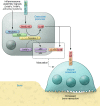Inflammatory osteolysis: a conspiracy against bone
- PMID: 28569732
- PMCID: PMC5451216
- DOI: 10.1172/JCI93356
Inflammatory osteolysis: a conspiracy against bone
Abstract
There are many causes of inflammatory osteolysis, but regardless of etiology and cellular contexts, the osteoclast is the bone-degrading cell. Thus, the impact of inflammatory cytokines on osteoclast formation and function was among the most important discoveries advancing the treatment of focal osteolysis, leading to development of therapeutic agents that either directly block the bone-resorptive cell or do so indirectly via cytokine arrest. Despite these advances, a substantial number of patients with inflammatory arthritis remain resistant to current therapies, and even effective anti-inflammatory drugs frequently do not repair damaged bone. Thus, insights into events such as those impacted by inflammasomes, which signal through cytokine-dependent and -independent mechanisms, are needed to optimize treatment of inflammatory osteolysis.
Conflict of interest statement
Figures


Similar articles
-
Modulation of osteoclast function in bone by the immune system.Mol Cell Endocrinol. 2009 Oct 30;310(1-2):40-51. doi: 10.1016/j.mce.2008.11.002. Epub 2008 Nov 14. Mol Cell Endocrinol. 2009. PMID: 19056462 Review.
-
Microgravity induces pelvic bone loss through osteoclastic activity, osteocytic osteolysis, and osteoblastic cell cycle inhibition by CDKN1a/p21.PLoS One. 2013 Apr 18;8(4):e61372. doi: 10.1371/journal.pone.0061372. Print 2013. PLoS One. 2013. PMID: 23637819 Free PMC article.
-
Inflammasomes in Alveolar Bone Loss.Front Immunol. 2021 Jun 9;12:691013. doi: 10.3389/fimmu.2021.691013. eCollection 2021. Front Immunol. 2021. PMID: 34177950 Free PMC article. Review.
-
[Osteocytic osteolysis : measurements of the volume of osteocytic lacunae].Clin Calcium. 2012 May;22(5):677-83. Clin Calcium. 2012. PMID: 22549192 Review. Japanese.
-
The cellular basis of bone resorption.Clin Orthop Relat Res. 1980 Sep;(151):283-93. Clin Orthop Relat Res. 1980. PMID: 7418318
Cited by
-
Context-Dependent Roles for Toll-Like Receptors 2 and 9 in the Pathogenesis of Staphylococcus aureus Osteomyelitis.Infect Immun. 2022 Nov 17;90(11):e0041722. doi: 10.1128/iai.00417-22. Epub 2022 Oct 13. Infect Immun. 2022. PMID: 36226943 Free PMC article.
-
Stress-Induced, Aseptic Osteolysis of the Mid-Tibia in a Revision Hinged Total Knee Arthroplasty Mimicking Infection.Arthroplast Today. 2022 Mar 9;14:116-120. doi: 10.1016/j.artd.2022.01.030. eCollection 2022 Apr. Arthroplast Today. 2022. PMID: 35281549 Free PMC article.
-
γδT cells in oral tissue immune surveillance and pathology.Front Immunol. 2023 Jan 10;13:1050030. doi: 10.3389/fimmu.2022.1050030. eCollection 2022. Front Immunol. 2023. PMID: 36703983 Free PMC article. Review.
-
Maxillary sinus floor elevation using Beta-Tricalcium-Phosphate (beta-TCP) or natural bone: same inflammatory response.J Mater Sci Mater Med. 2019 Aug 22;30(9):97. doi: 10.1007/s10856-019-6299-6. J Mater Sci Mater Med. 2019. PMID: 31440845
-
Targeting thymidine phosphorylase as a potential therapy for bone loss associated with periprosthetic osteolysis.Bioeng Transl Med. 2021 Jun 8;6(3):e10232. doi: 10.1002/btm2.10232. eCollection 2021 Sep. Bioeng Transl Med. 2021. PMID: 34589604 Free PMC article.
References
-
- Pasco JA, et al. High-sensitivity C-reactive protein and fracture risk in elderly women. JAMA. 2006;296(11):1353–1355. - PubMed
Publication types
MeSH terms
Substances
Grants and funding
LinkOut - more resources
Full Text Sources
Other Literature Sources

